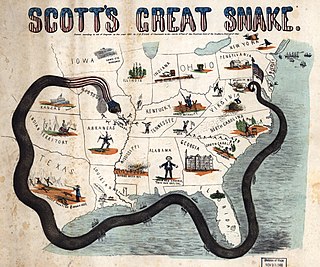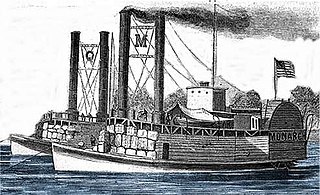
The American Civil War was a civil war in the United States between the Union and the Confederacy, which was formed in 1861 by states that had seceded from the Union. The central conflict leading to war was a dispute over whether slavery should be permitted to expand into the western territories, leading to more slave states, or be prohibited from doing so, which many believed would place slavery on a course of ultimate extinction.

The Battle of Atlanta took place during the Atlanta Campaign of the American Civil War on July 22, 1864, just southeast of Atlanta, Georgia. Continuing their summer campaign to seize the important rail and supply hub of Atlanta, Union forces commanded by William Tecumseh Sherman overwhelmed and defeated Confederate forces defending the city under John Bell Hood. Union Major General James B. McPherson was killed during the battle, the second-highest-ranking Union officer killed in action during the war. Despite the implication of finality in its name, the battle occurred midway through the Atlanta campaign, and the city did not fall until September 2, 1864, after a Union siege and various attempts to seize railroads and supply lines leading to Atlanta. After taking the city, Sherman's troops headed south-southeastward toward Milledgeville, the state capital, and on to Savannah with the March to the Sea.
The Army of West Mississippi was a Union army that served in the Western Theater of the American Civil War. It was virtually the same force as the Army of the Gulf, but was renamed when it became a part of the Military Division of West Mississippi, in the Department of the Gulf commanded by Maj. Gen. Edward Canby.
The Second Battle of Lexington was a minor battle fought during Price's Raid as part of the American Civil War. Hoping to draw Union Army forces away from more important theaters of combat and potentially affect the outcome of the 1864 United States presidential election, Sterling Price, a major general in the Confederate States Army, led an offensive into the state of Missouri on September 19, 1864. After a botched attack at the Battle of Pilot Knob, the strength of the Union defenses at Jefferson City led Price to abandon the main goals of his campaign.

The XVI Army Corps was a corps of the Union Army during the American Civil War. The corps rarely fought as a single unit, as its divisions were often scattered across the country.

Andrew Jackson Smith was a United States Army general during the American Civil War, rising to the command of a corps. He was most noted for his victory over Confederate General Stephen D. Lee at the Battle of Tupelo, Mississippi, on July 14, 1864.

The Red River campaign, also known as the Red River expedition, was a major Union offensive campaign in the Trans-Mississippi theater of the American Civil War, the campaign taking place from March 10 to May 22, 1864. It was launched through the densely forested gulf coastal plain region between the Red River Valley and central Arkansas towards the end of the war. The offensive was intended to stop Confederate use of the Louisiana port of Shreveport, open an outlet for the sugar and cotton of northern Louisiana, and to split the Confederate lines, allowing the Union to encircle and destroy the Confederate military forces in Louisiana and southern Arkansas. It marked the last major offensive attempted by the Union in the Trans-Mississippi Theater.

The Army of Missouri was a Confederate field army during the American Civil War that served as part of the Trans-Mississippi Department. It was established in September 1864 under the command of Major General Sterling Price to invade Missouri. The fall campaign was unsuccessful, and the army retreated to Arkansas, where it was broken up and reabsorbed into the Army of the Trans-Mississippi.

The Mississippi River Squadron was the Union brown-water naval squadron that operated on the western rivers during the American Civil War. It was initially created as a part of the Union Army, although it was commanded by naval officers, and was then known as the Western Gunboat Flotilla and sometimes as the Mississippi Flotilla. It received its final designation when it was transferred to the Union Navy at the beginning of October 1862.

John Gregg was an American politician who served as a deputy from Texas to the Provisional Congress of the Confederate States from 1861 to 1862. He served as a brigade commander officer of the Confederate States Army and was killed in action during the Siege of Petersburg.

The western theater of the American Civil War encompassed major military operations in the states of Alabama, Georgia, Florida, Mississippi, North Carolina, Kentucky, South Carolina and Tennessee, as well as Louisiana east of the Mississippi River. Operations on the coasts of these states, except for Mobile Bay, are considered part of the Lower Seaboard Theater. Most other operations east of the Appalachian Mountains are part of the eastern theater. Operations west of the Mississippi River took place in the trans-Mississippi theater.
The trans-Mississippi theater of the American Civil War was the scene of the major military operations west of the Mississippi River. The area is often thought of as excluding the states and territories bordering the Pacific Ocean, which formed the Pacific coast theater of the American Civil War (1861–1865).

The lower seaboard theater of the American Civil War encompassed major military and naval operations that occurred near the coastal areas of the Southeastern United States: in Alabama, Florida, Louisiana, Mississippi, South Carolina, Texas, Port Hudson, Louisiana, and points south of it.

USS Monarch was a United States Army sidewheel ram that saw service in the American Civil War as part of the United States Ram Fleet and the Mississippi Marine Brigade. She operated on the Mississippi River and Yazoo River during 1862 and 1863.

Mississippi was the second southern state to declare its secession from the United States, doing so on January 9, 1861. It joined with six other southern states to form the Confederacy on February 4, 1861. Mississippi's location along the lengthy Mississippi River made it strategically important to both the Union and the Confederacy; dozens of battles were fought in the state as armies repeatedly clashed near key towns and transportation nodes.

The Army of the Trans-Mississippi was a major Confederate army under the Department of the Trans-Mississippi during the American Civil War. It was the last major Confederate command to surrender, submitting on May 26, 1865, exactly one month after General Johnston had surrendered in the eastern United States.
The Army of Arkansas was a Union Army that served in the Trans-Mississippi Theater during the American Civil War. This force functioned exclusively in the state of Arkansas.
The 83rd Indiana Infantry Regiment, sometimes called 83rd Indiana Volunteer Infantry Regiment, was an infantry regiment that served in the Union Army during the American Civil War.

On the onset of the American Civil War in April 1861, Ulysses S. Grant was working as a clerk in his father's leather goods store in Galena, Illinois. When the war began, his military experience was needed, and congressman Elihu B. Washburne became his patron in political affairs and promotions in Illinois and nationwide.
89th Indiana Infantry Regiment was an infantry regiment that served in the Union Army in the Western Theater of the American Civil War.













